


|
|
||||||||||||||||
|
|
||||||||||||||||
|
|
|||
|
|
Lincoln
Lincoln Cathedral, The Cathedral Church of the Blessed Virgin Mary of Lincoln, is one of England’s finest Gothic cathedrals. Located in the historic city of Lincoln, it was commissioned by William the Conqueror in 1072 and was constructed on the site of an Anglo-Saxon church. The building was completed in 1092 under the supervision of Bishop Regimus. In 1142 it was destroyed by fire but was rebuilt and expanded by Bishop Alexander (known as ‘the Magnificent'). In 1185 the cathedral was severely damaged by an earthquake, with reconstruction beginning in 1192 by Bishop Hugh who was later to become Saint Hugh. The work was paid for by the local people including the Swineherd of Stowe who gave his life savings to the project. His statue sits on top of the northwest turret opposite that of St Hugh which is on the southwest turret. Hugh used the Gothic style of architecture which used pointed arches, ribbed vaults, and flying buttresses. This allowed larger windows and wider roof spans, although the Norman style of architecture with its round arches for the doors and windows can still be seen. As construction work was to last for a period of 100 years, Hugh was not to see the completion of the Transept or Nave, as he died in 1200 and - like many of the Cathedral’s Bishops - was buried in the Cathedral in what is now St Hugh Chapel. 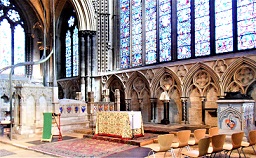 A number of problems occurred during the construction work; the central towers collapsed at the end of the 1230s and had to be rebuilt; while the nave, having been completed in the middle of the 13th century, was joined to the remains of the Norman west end, although its alignment was out of line, resulting in a kink which can be seen today by looking up to the ceiling just inside the entrance. In 1255 Henry III (1216 – 72) allowed the removal of part of the town wall to enable the cathedral to be enlarged, this included the replacement of the rounded chapel constructed by St Hugh with the current square one at the east end. It was at this time that work began on the Angel Choir. The two large stained-glass windows were added in 1330. These are the Dean’s Eye and the Bishop’s Eye which are situated at either end of the transept. During that time, it was common for cathedral windows to contain images from the bible. However, at Lincoln, there are very few images; although some can be seen of the Saints Paul, Andrew, and James. The central tower was extended to its present height between 1307 and 1311 with the western towers being raised at the end of the 14th century. Lead-covered spires were later added to all three towers with the central tower making the Cathedral the tallest building in the world (160m) overtaking that of the Great Pyramid of Giza. Despite the central spire collapsing during a hurricane in 1549, its original height was not surpassed until the construction of the Eiffel Tower in Paris in 1889. The other two towers also had spires, these were 30.7m high, but these were removed in 1807 after their weight, and the poor foundations threatened to cause the towers to collapse. It had been planned to remove the spires in 1726 but the cathedral was besieged by the people of Lincoln in protest, so the plan was abandoned. The towers contain a total of 20 bells, with the quarter-hour striking clock, Great Tom being installed early in the 19th century. The reformation in 1540 resulted in King Henry VIII (1509 – 1547) seizing many of the cathedral's precious objects including vestments, plates, and statues encrusted with jewels, whilst the English Civil War (1642 - 1651) saw the destruction of many of the shrines. With the Restoration of the Monarchy in 1660, new building work commenced, including the construction of the ‘Wren Library’ named after its architect, Sir Christopher Wren. This contains a collection of over 277 rare manuscripts, including the text of the Venerable Bede. Visitors enter the cathedral at the West Front. The main door, however, is only fully opened to receive the Sovereign, the Lord Lieutenant, or the Judges when they come in State. 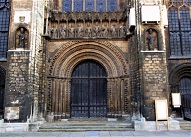 On entry into the Nave, there is a spectacular view of its pillars and ribbed vaulting. In the Nave, near the entrance is the baptismal font. Made of Tournai marble, with carvings of mythical beasts around its sides, it was brought to Lincoln from Belgium in the 12th century. It is located at the entrance to signify that baptism is the start of the Christian’s journey through life. At the end of the Nave is the altar standing in front of the crossing and the Transept, across the crossing is the intricate carved stone Choir Screen constructed in the 1330s to separate the choir from the rest of the Cathedral, it still bears traces of blue, red, silver and gold which originally coloured it. Above the choir screen is the organ which was built in 1898 utilising the previous organ case from 1826. Although only a few organ pipes are on show it actually contains over 4000, the majority are hidden on their sides in the triforium (The passageway below the top windows). Within the transept are a number of chapels, including those dedicated to the armed forces. Off the transept leads two aisles, one to the south of the choir screen and one to the north. An interesting tomb situated in the North Choir Aisle is the ‘cadaver’ tomb of Bishop Richard Fleming. He was Dean of Lincoln from 1452-83. The tomb shows the bishop twice, at the top he is depicted in good health wearing bishops’ robes, while below he is shown in a shroud as an emaciated corpse. Thus, reminding people that they can’t retain their wealth and glory when they die. Behind the transept and the choir screen is St Hugh’s choir with its wonderfully carved woodwork and Pulpit. This is accessed from the north and south choir aisles. Located in St Hugh’s Choir is the Eagle Lectern with its outspread wings to hold the bible. The tradition of the eagle dates from the Middle Ages and symbolises clarity of vision and the ability to be removed from earth's distractions and be closer to heaven. The eagle is also the symbol of St John. The lectern is made of brass and dates from 1667, an identical one can be found in Canterbury Cathedral. At the far end of St Hugh’s Choir is the High Altar 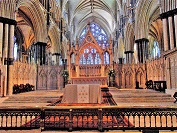 Behind this, in the Angel Choir, can be seen the great east window. This was built around 1275 and was the first Gothic eight-light window in the world. 18 metres in height it was glazed in 1855. To the right of the High Altar are two tombs, the larger of the two is that of Katherine Swynford (1350-1403), the wife of John of Gaunt, while the smaller is of her daughter Joan, Countess of Westmoreland. Their descendants were to be the Plantagenet kings Richard III and Edward IV from whom descended the Tudor and Stuart dynasties and subsequent British monarchs. Behind St Hugh’s Choir are the Angel Choir and the chantry chapels which were added in the 15th and 16th centuries. The furthest one, located in the South Choir Aisle is that of John Russell the Bishop of Lincoln 1480-1494. This was painted with murals by Duncan Grant between 1956-58. These were particularly modern and were thought to be inappropriate, so the chapel was closed for a number of years. Beyond the Angel Choir stands a shrine to St Hugh. There is much speculation as to where his body is, as his shine was removed and damaged during the Reformation and the Civil War. It has been suggested that his remains were found in 1889 along with eight other graves under the Chapter House floor, although no conclusive evidence has been found that this was St Hugh. Also in the Angel Choir is the visceral tomb (A tomb for the internal body organs) of Eleanor of Castile, which is a duplicate of the tomb of the one found in Westminster Abbey. Eleanor was the wife of Edward I and she died near Lincoln in 1290. Her body was taken to London and a Cross, known as an Eleanor Cross, was erected at each place she stopped on the journey. Made of Sussex marble, the tomb has Eleanor's effigy in copper gilt on a copper top. One of the most famous things in Lincoln Cathedral is the Lincoln Imp. 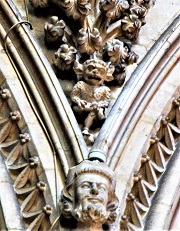 This is a small stone carving situated at the top of a stone pillar in the Angel Choir. Legend has it that two mischievous imps entered the cathedral and started to cause havoc by smashing things and throwing rocks. An angel entered the cathedral and ordered the imps to stop, and when they did not, the angel turned one into stone, whereupon the other quickly left. Lincoln Cathedral also has a Cloister; something that is common in a monastic cathedral but not in a secular one like Lincoln. Built originally in the 13th century the Cloister was rebuilt in 1674 by Sir Christopher Wren during his work on the Cathedral. Just off the Cloister, there is now a museum telling the story of the cathedral. The museum leads into a souvenir shop and café, Also from the Cloister is the entrance to the library and The Chapter House. 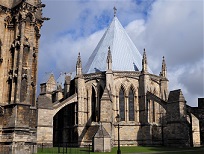 The Chapter House is a circular building that contains one column with twenty stone ribs extending from it. 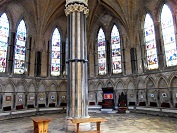 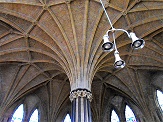 It was named the Chapter House because the governing body of the cathedral, known as the chapter, met there. Later, the term chapter was used for the governing body itself. When King John (1199 – 1216) placed his seal on Magna Carta at Runnymede in 1215, the Bishop of Lincoln was one of the signatories, and one of the four remaining original copies of the document was held in Lincoln Cathedral before being transferred to Lincoln Castle. The cathedral has been used for a number of films; the most famous of which is The Da Vinci Code starring Tom Hanks which was made in 2005. Although the story was actually set in Westminster Abbey, Lincoln Cathedral was selected when permission to film in the Abbey was refused. The chapter house was adorned with painted murals and polystyrene replicas of the Abbey. The cathedral also doubled as Westminster Abbey in 2007 for the film Young Victoria. To see more photographs and take a virtual tour of the site click on the photoshow below.
|
|
|
|
|
|||
All Photographs were taken by and are copyright of Ron Gatepain
| Site Map |